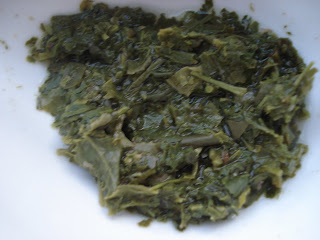On to the tasting, I tasted the following 2 teas together so I could do a comparison:
1. Okame Hyotto Cha Gold (award winning sencha)
2. Sencha with Cherry Blossoms
Here are my tasting notes:
Okame Hyotto (L)
Dry leaves: dark green, flat and narrow, needle-like, has a shine to it.
I used 1 tsp (or about 3 grams) for each tea.
and the Sencha with Cherry Blossoms (R)
Dry leaves: dark green leaves but not as vibrant a the Okame, flat and narrow, needle-like, some light pink cherry blossoms mixed in making it look pretty!
Steep time was just over 1 min using water that was not boiling. I don't have a thermometer or those high-tech water kettles but I let the water sit for 5-6mins after the boil before infusing the leaves.
Infused leaves:
Okame Hyotto (L)
The infused leaves were slightly more bright green then the Sencha with cherry blossoms on the right. They also look like wet grass clippings but not as fine. The aroma of the Okame Hyotto leaves was very strong, grassy and ++ of a seaweed/ocean, maybe even sweet crab aroma.
Sencha with Cherry Blossoms (R)
Leaves were similar to the Okame but slightly more darker green with a bit of brown. The aroma was also similar but not as pungent.
As you can see, the Okame has a brighter colour to it, it was more yellow-green, the Sencha with Cherry Blossoms had a slightly more greenish tinge to it. Both were cloudy and at the bottom of the cup there was tea dust.
Taste: Both were grassy with a seaweed taste, but the Okame was definitely stronger! They were both smooth however, the Okame tasted "fresher" and had a slightly cleaner taste. Initially, I didn't find them as sweet as I expected but when the tea cooled slightly, the sweetness came out more and it felt more like a medium bodied tea. Overall I did find both teas to be good, but if you are a fan of sencha tea, I think you would enjoy the Okame Hyotto more.
I'm not sure if the cherry blossoms are supposed to be impart some taste or are added for appearance and aroma. For me, I didn't notice anything different and the fragrance did not come out. It may be possible that the flowers were a bit old or there requires a larger percentage of blossoms.
I steeped the leaves a 2nd time and it was still a good cup of tea, steep time was a little longer though.
Taste: Both were grassy with a seaweed taste, but the Okame was definitely stronger! They were both smooth however, the Okame tasted "fresher" and had a slightly cleaner taste. Initially, I didn't find them as sweet as I expected but when the tea cooled slightly, the sweetness came out more and it felt more like a medium bodied tea. Overall I did find both teas to be good, but if you are a fan of sencha tea, I think you would enjoy the Okame Hyotto more.
I'm not sure if the cherry blossoms are supposed to be impart some taste or are added for appearance and aroma. For me, I didn't notice anything different and the fragrance did not come out. It may be possible that the flowers were a bit old or there requires a larger percentage of blossoms.
I steeped the leaves a 2nd time and it was still a good cup of tea, steep time was a little longer though.
















